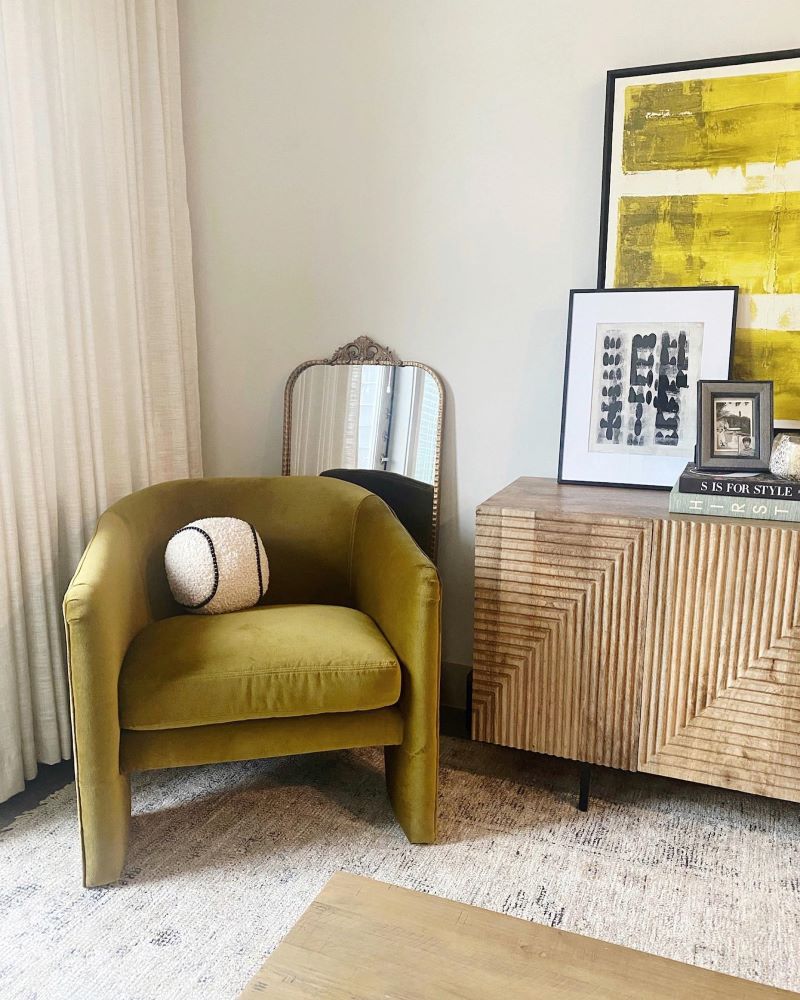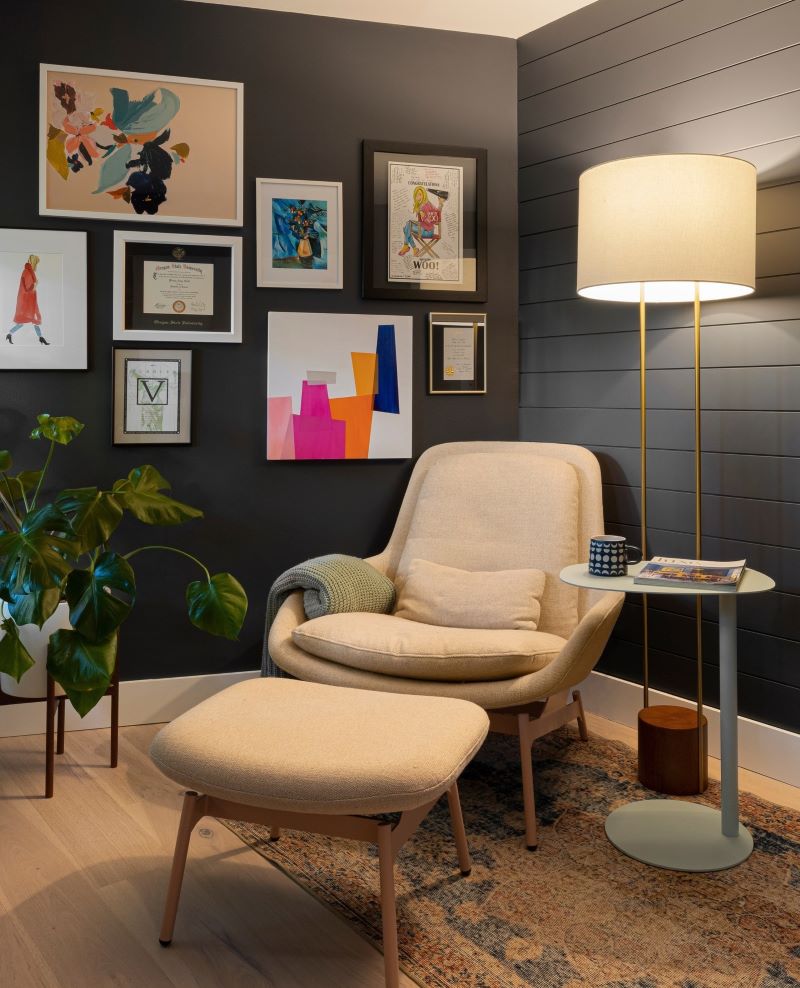What separates a house from a home? It’s the love and attention to small details that turn four blank walls into a safe haven that is completely you. Seasoned designers have mastered this art of transforming living spaces into homes that speak volumes about the style and personality of the people who inhabit them.
From color psychology to the perfect placement of eye-catching art, we’re here to give you the 10 game-changing techniques that professionals use so that you, too, can whip up some decor magic in your living space!
1. Choose your style and aesthetic
Before selecting decor pieces, it’s essential to understand your personal style. Your home should feel like an extension of you—whether that means a sleek, modern space or a cozy, collected-over-time look. Identifying your aesthetic helps create a cohesive and intentional design.
There are many interior design styles, each with unique characteristics. Exploring them can help you pinpoint what resonates most with you:
- Contemporary – Clean lines, neutral tones, and open spaces define this ever-evolving style. It prioritizes function and simplicity while incorporating modern materials like glass, metal, and wood.
- Boho (Bohemian) – A relaxed, eclectic mix of global influences, layered textiles, vintage finds, and natural elements. Think rattan, macramé, and bold patterns.
- Minimalist – Rooted in the "less is more" philosophy, this style focuses on decluttered spaces, neutral colors, and high-quality essentials with no unnecessary embellishments.
- Eclectic – A carefully curated mix of styles, patterns, textures, and time periods. This look is bold, artistic, and highly personalized.
- French country – Elegant yet rustic, with distressed woods, vintage furnishings, soft muted colors, and ornate details that bring old-world charm.
- Midcentury modern – Defined by sleek lines, organic shapes, and functional yet stylish furniture from the 1950s and 60s. It often incorporates warm wood tones and retro elements.
- Scandinavian – A mix of minimalism and coziness, featuring light woods, soft textiles, and a neutral color palette with functional yet aesthetically pleasing furniture.
- Industrial – Inspired by old factories and lofts, this style highlights raw materials like exposed brick, metal, and reclaimed wood. Often paired with darker hues and open layouts.
- Farmhouse (modern & traditional) – A welcoming and cozy style with rustic elements, distressed wood, shiplap walls, and vintage-inspired decor. Modern farmhouse blends this with contemporary touches.
- Japandi – A fusion of Japanese minimalism and Scandinavian functionality, focusing on simple lines, natural materials, and a sense of calm balance.
- Traditional – Rich wood tones, ornate details, and classic furniture shapes define this timeless style that draws influence from European interiors.
- Transitional – A perfect balance between traditional and contemporary, blending timeless pieces with modern updates for a polished but approachable look.
If you’re unsure what aesthetic resonates with you the most, resources like Minted’s guide to different art styles, publications full of inspiration like Architectural Digest, or design quizzes are a great place to start.
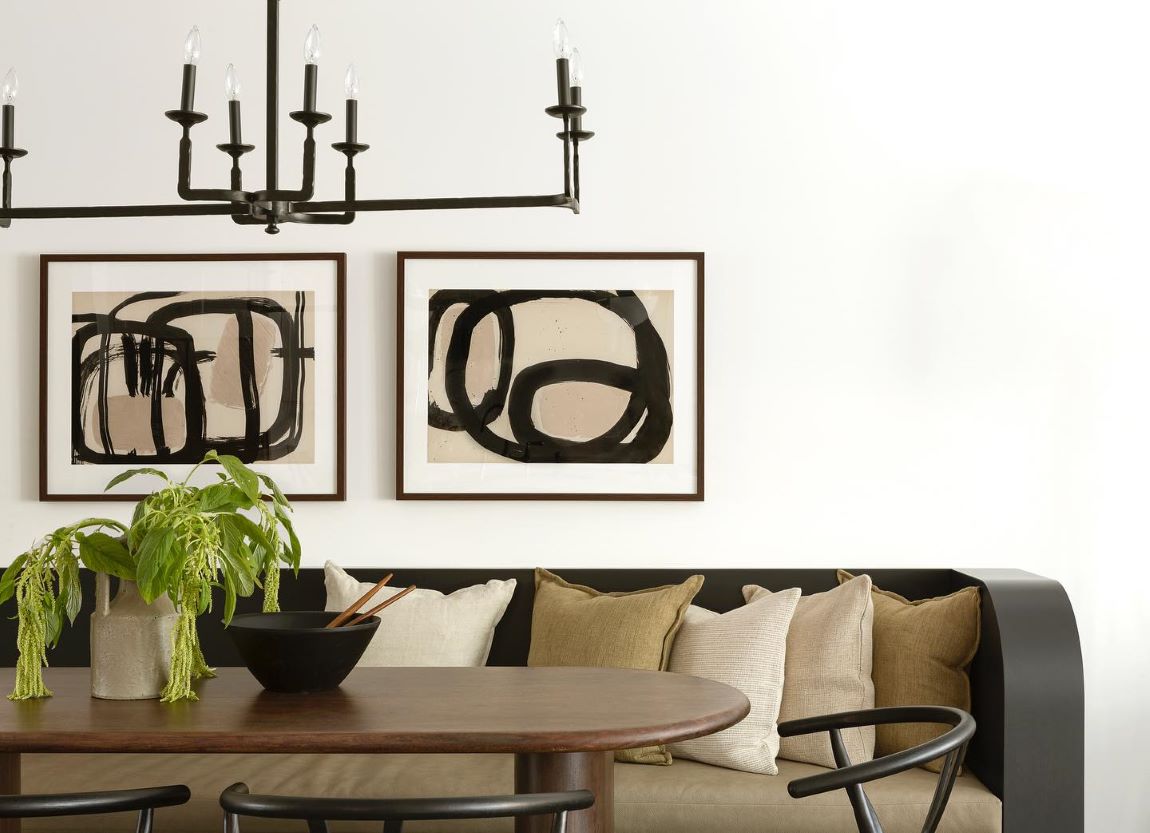
Photo by: Stafford House Studio
Creating a mood board for your space
Once you’ve settled on your style, it’s time to envision how it might come to life in your space—and with what you already own. Mood boards help you visualize and refine your design before making decisions.
Start by gathering inspiration from Pinterest, design magazines, and home decor brands, saving images that reflect your style. Digital tools like Canva or Adobe Photoshop allow you to arrange these elements, add color swatches, and experiment with layouts, helping you identify patterns in your aesthetic.
Go the extra mile to identify unique art selections you want to see in your home and add them to your mood board. You can explore Minted’s wide variety of art to make this process easier. Once you’re sure of your collection, you don’t have to worry about sourcing anything!
2. Implement color psychology
Color does more than just decorate a room—it sets the mood and influences how a space feels. The key is understanding how colors impact emotions and using them to enhance your home. Bright, saturated colors tend to feel bold and playful, while muted, earthy tones create a more relaxed, understated aesthetic. If you want a space to feel lively, go for vibrant hues. For something more soothing, go for softer, desaturated shades.
For example, warm tones like reds, oranges, and yellows bring energy, making them great for social areas like kitchens and dining rooms. Cool shades like blues, greens, and purples create a calming effect, ideal for bedrooms and workspaces. Even neutrals—soft whites, grays, and beiges—can shift a room’s atmosphere, adding warmth or a modern edge depending on the shade.
But here’s the best part: you don’t have to commit to painting walls to play with color psychology! Artwork is a game-changer when it comes to setting the mood. A bold abstract piece can wake up a neutral space, while a serene landscape print can make a bedroom feel even more relaxing. Even small touches—like colorful framed prints or statement textiles—can shift the feel of a room without a big commitment.
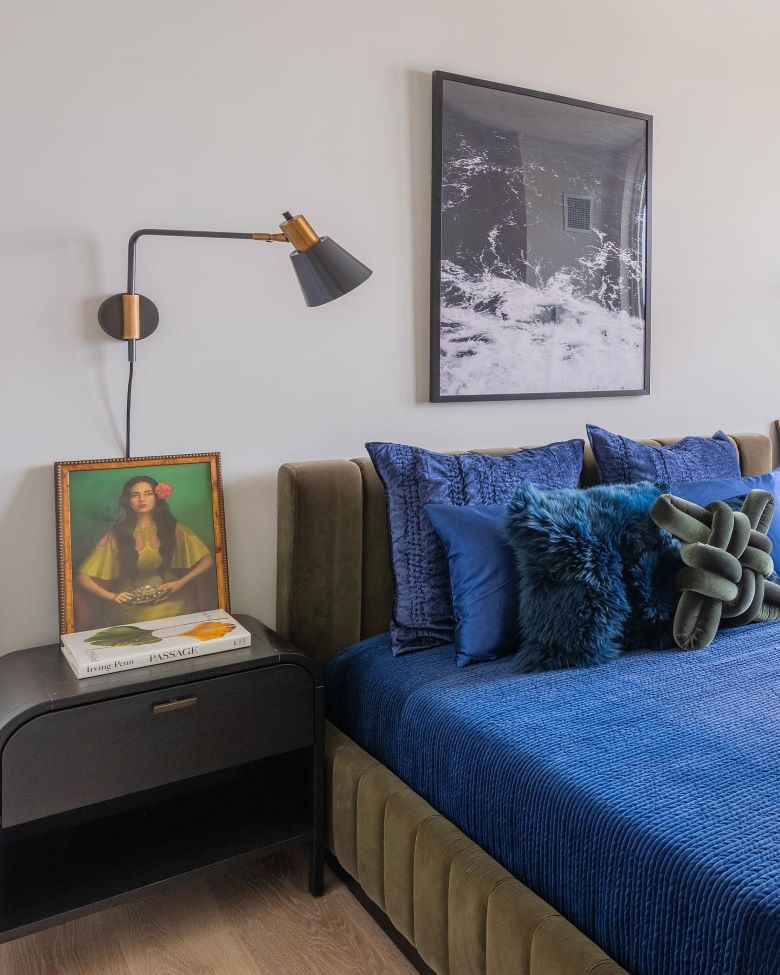
Photo by: TF Cornerstone
Choose complementary colors and themes
Choosing colors isn’t just about picking favorites—it’s about creating balance. Different color combinations can dramatically change how a space feels:
- Complementary colors (blue and orange, red and green) create a bold contrast and make the space feel lively.
- Analogous colors (yellow and green, blue and teal) offer a seamless, natural transition between hues.
- Monochromatic schemes (varying shades of a single color) add depth and sophistication without overwhelming the space.
Art plays a major role in pulling these elements together. Instead of just matching colors to your furniture, think about how different shades interact. A warm-toned living room can feel more dynamic with a splash of cool blue in an art piece, while a neutral space can be energized with pops of contrasting colors.
The goal is to create a natural color flow throughout your home. If you're looking for inspiration on what colors to choose, our color theory guide walks you through these combinations in much more detail!
3. Elevate your space with accent pieces
While the color palette and larger pieces of furniture set the tone for a space, it’s the accent pieces—vases with fresh blooms, sculptural objects, and inviting throw pillows—that create warmth and personality. Think beyond the walls: decorative trays keep cherished items organized, statement clocks add character, and table centerpieces become natural conversation starters. Each piece adds depth, turning your space into a layered, lived-in expression of your style.
The key is in the mix—smooth ceramics, textured fabrics, warm woods, and sleek metals all work together to create a space that feels dynamic and thoughtfully curated. Accent pieces are a fun way to play around with your space, and Minted’s collection of accent pieces makes it easy to find a piece that speaks to your style.
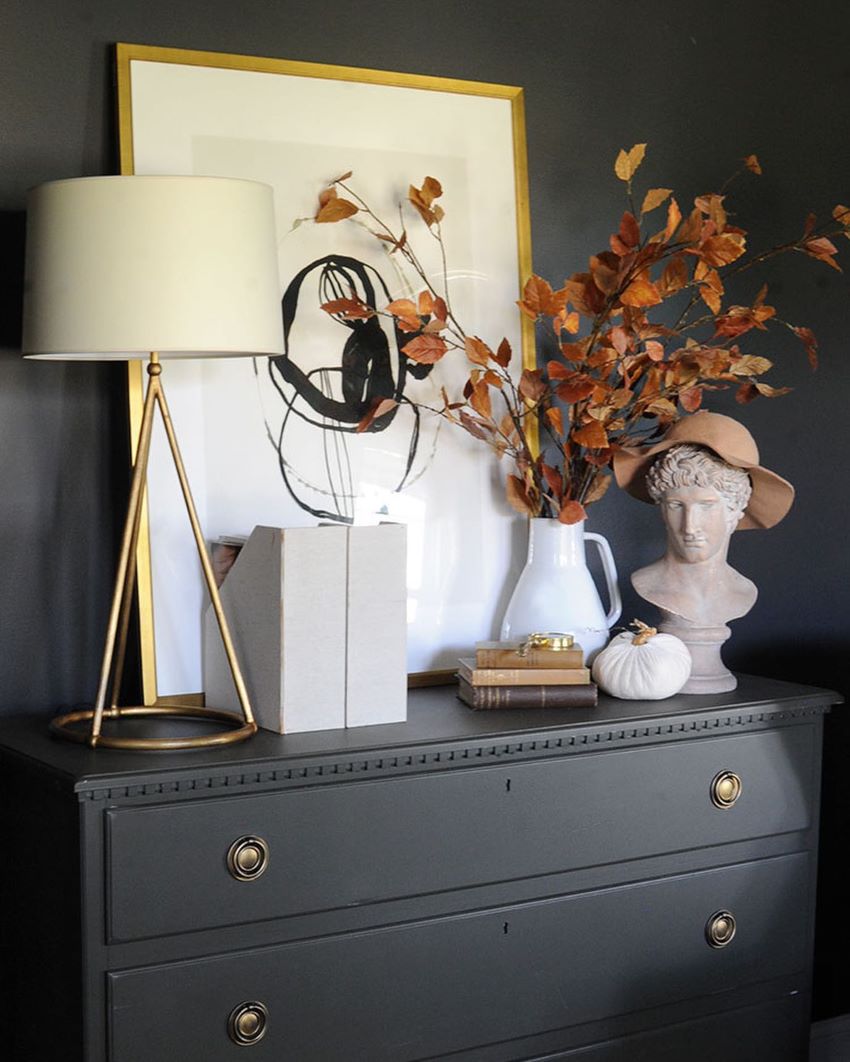
Photo by: Dear Lillie Studio
Styling coffee tables and consoles
A well-styled coffee table or console does more than just hold your essentials—it adds character to your space. The trick experts use?
Grouping items in threes for a balanced, visually appealing arrangement. Try stacking a few art books, adding a candle, and finishing with a sculptural accent to create effortless charm. Playing with height and texture—like pairing a tall vase with shorter, chunky objects—adds depth and interest to your display.
Choosing throw pillows and textiles
Throw pillows and textiles are the easiest way to refresh a space, adding warmth, texture, and personality. The key to a well-layered look? Mixing patterns and textures with intention. Start with a cohesive color palette, then play with different scales—pairing a bold, oversized print with a more intricate pattern keeps things visually interesting without feeling overwhelming.
Texture is just as important as pattern. A mix of smooth silks, cozy linens, plush velvets, and crisp cotton brings depth and contrast, making a space feel inviting. You can also go a step further and experiment with embroidered fabrics to add more texture to your space.
4. Choose the right wall decor
How you choose to decorate the walls of your space can completely shape a room’s atmosphere. Instead of leaving them blank or defaulting to basic artwork, think about how you can layer different elements to jazz them up and tell a story.
Choose the right wall art
Selecting the right wall art will help you define the entire room's mood. For example, textured paintings in muted tones in a formal living room can add sophistication without overpowering the space. If you prefer a more relaxed, collected look, a gallery wall with a mix of prints and photography can bring personality and movement. And if you're drawn to bold statements, a large-scale piece can instantly become the focal point, grounding the entire room.
Want a curated look without the hassle? Minted's wall art sets offer pre-selected collections that give you a cohesive art selection without much effort. If you’re looking for more direction with your wall art, we’ve got you covered with a guide to pick the right wall art for every room.
Consider scale and proportion
The right artwork can bring a room together, but if it’s the wrong size, it can throw off the entire balance. Here are some simple guidelines to get it just right:
- Artwork above furniture – A piece should be about two-thirds the width of the furniture below it (sofas, beds, consoles) for a well-proportioned look.
- Large empty walls – If one piece isn’t enough, try grouping multiple smaller pieces to create a cohesive arrangement.
- Three-eighths rule – Aim for artwork to take up about 57% of a wall’s width, leaving enough negative space for a clean, intentional look.
- Gallery walls – Mix sizes and orientations, but keep consistent spacing (2–4 inches apart) so the arrangement feels balanced rather than cluttered.
- Eye-level placement – For the best visual impact, the center of the artwork should be about 57 inches from the floor.
These aren’t rigid rules, but they offer a good starting point (we also share a bunch more tips for getting the proportions right in this article on choosing the right art size). If something feels off, step back and adjust until the space looks naturally balanced.
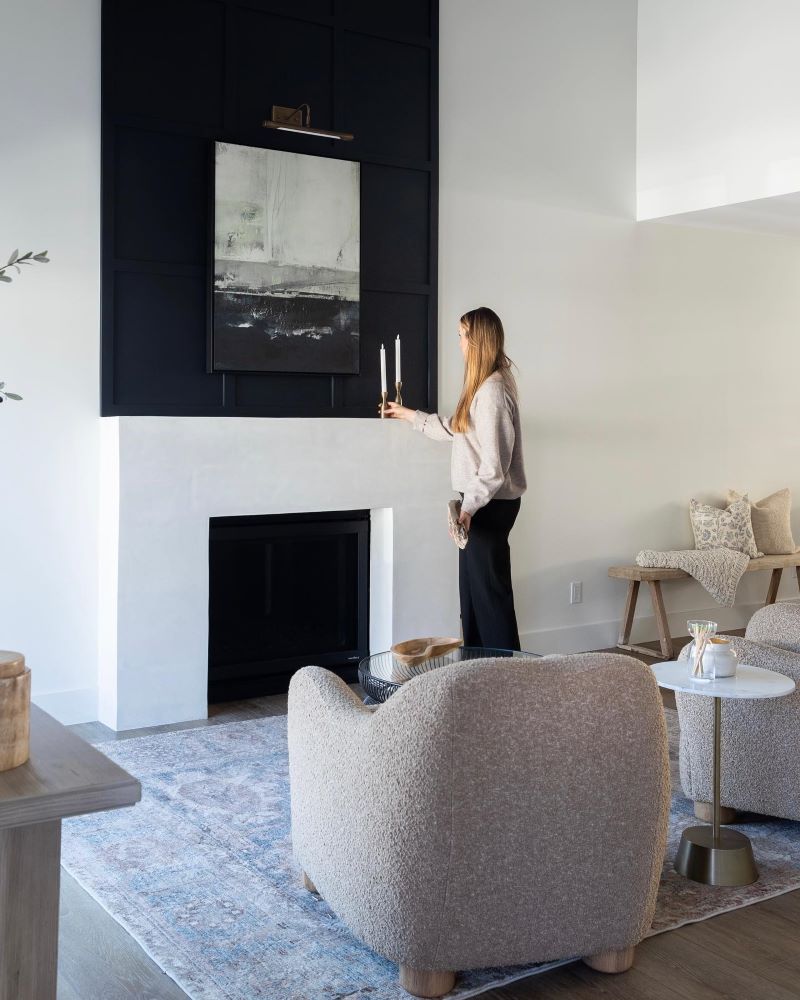
Photo by: Genoway Interiors
Other Wall Decor Ideas
Wall art is a great addition to any space, but you don’t have to be limited to it. Bring more dimension into a room by adding mirrors, shelves, books, or decorative pieces on your walls.
Here are just a few simple tricks that the pros rely on:
- A bold mural or wallpaper can instantly brighten a space and add visual interest.
- Decorative panels introduce subtle dimensions to an otherwise flat room.
- Mirrors have been the secret weapon of interior decorators for ages! They reflect light and make a room feel bigger — instantly opening up the space.
- Floating shelves are perfect for displaying framed prints, sculptures, or treasured keepsakes in a way that feels intentional rather than cluttered.
The idea is to mix different sizes and mediums—a framed print next to a canvas, maybe even a small textile piece or a sculptural object—to create a display that feels layered and collected over time. There’s no single “right” way to do it, but stepping back and playing with balance ensures everything feels cohesive rather than chaotic.
5. Use lighting in home decor
Lighting is not only for seeing things but for seeing things right! With all the gorgeous decor and art you’ve collected, it only makes sense to see it in the best possible light. A well-lit space relies on three layers: ambient, task, and accent lighting.
- Ambient lighting (overhead fixtures, recessed lights) creates a general glow.
- Task lighting (desk lamps, under-cabinet lights) ensures functionality,
- Accent lighting (picture lights, wall sconces) highlights the details that deserve attention—especially artwork.
To create a gallery-like feel, pair ceiling-mounted accent lights with well-placed floor or table lamps. Dimmable fixtures let you control the intensity, keeping the focus on the art without overwhelming it. Those are the basics; now it comes down to selecting the right light pieces.
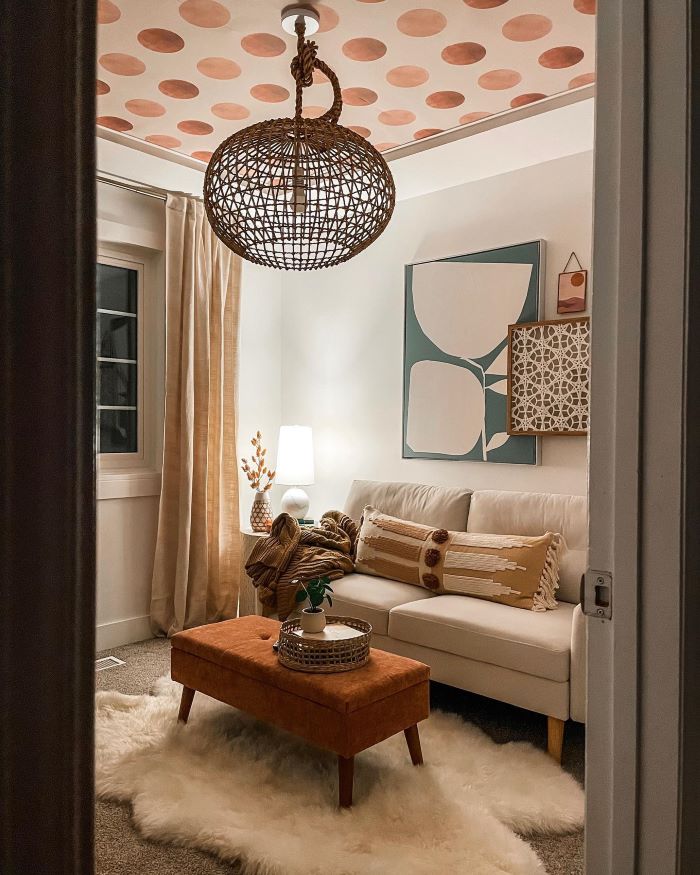
Photo by: The Dwelling Co
Choosing the right light fixtures
In any thoughtfully constructed home, you’ll find a mix of different light fixtures. Chandeliers add drama and elegance, sconces create subtle ambiance, and pendant lights offer intimate, focused illumination. Floor lamps? They’re the multitaskers of lighting, effortlessly filling dark corners or adding an extra layer of warmth.
Beyond the fixtures themselves, playing with light temperature is an easy way to shape the feel of a room. Warm lighting (soft white or amber tones) makes living spaces feel cozy and inviting, while cooler lighting (daylight tones) keeps workspaces feeling bright and focused.
At Minted, we offer a variety of functional and decorative light fixtures. Whether table lamps or handcrafted sconces, there is a light for every mood!
6. Think differently for every space
Every room in your home serves a different purpose, so why approach them all the same way? A living room should feel inviting, with comfortable seating that encourages conversation. Your bedroom, on the other hand, is a retreat—soft lighting, cozy textiles, and calming colors can make it a true sanctuary. In the kitchen, function takes center stage, but that doesn’t mean sacrificing style—thoughtful storage solutions and well-placed decor can make the space both practical and beautiful.
Living room decorating essentials
Your living room is more than just a space for lounging—it’s the centerpiece of your home, where comfort meets style. The key to a well-designed living room is balance: between function and aesthetics, structure and flow, bold statements and subtle details.
- Create a natural flow: Consider how people move through the space. Position seating to encourage conversation rather than just facing the TV. If the room has a natural focal point—a fireplace, an art piece, or a large window with a view—arrange furniture to highlight it.
- Anchor the space with a statement rug: A large rug that extends under all key furniture pieces makes the space feel warm and inviting.
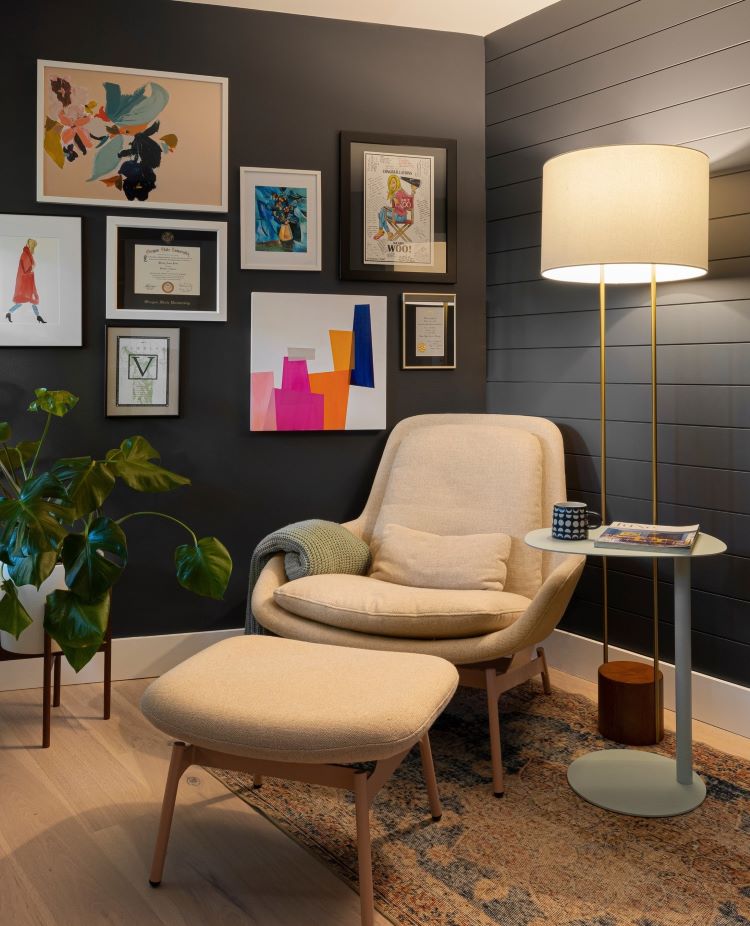
Photo by: Teal & Scott
- Play with proportions: Mix shapes and sizes to avoid a flat, one-dimensional look. If you have a sleek, streamlined sofa, introduce contrast with round coffee tables, sculptural side tables, or an oversized floor lamp. Varying heights keep the eye moving and make the room feel more dynamic.
- Think beyond the couch: Seating doesn’t just have to be a sofa and armchairs. Consider adding a built-in window bench, a statement accent chair, or a pair of ottomans that can be moved around as needed. These elements offer flexibility while making the space feel more thoughtfully arranged.
The best living rooms feel collected, not staged. A mix of old and new, bold and neutral, structured and organic, creates a space that’s inviting and stylish.
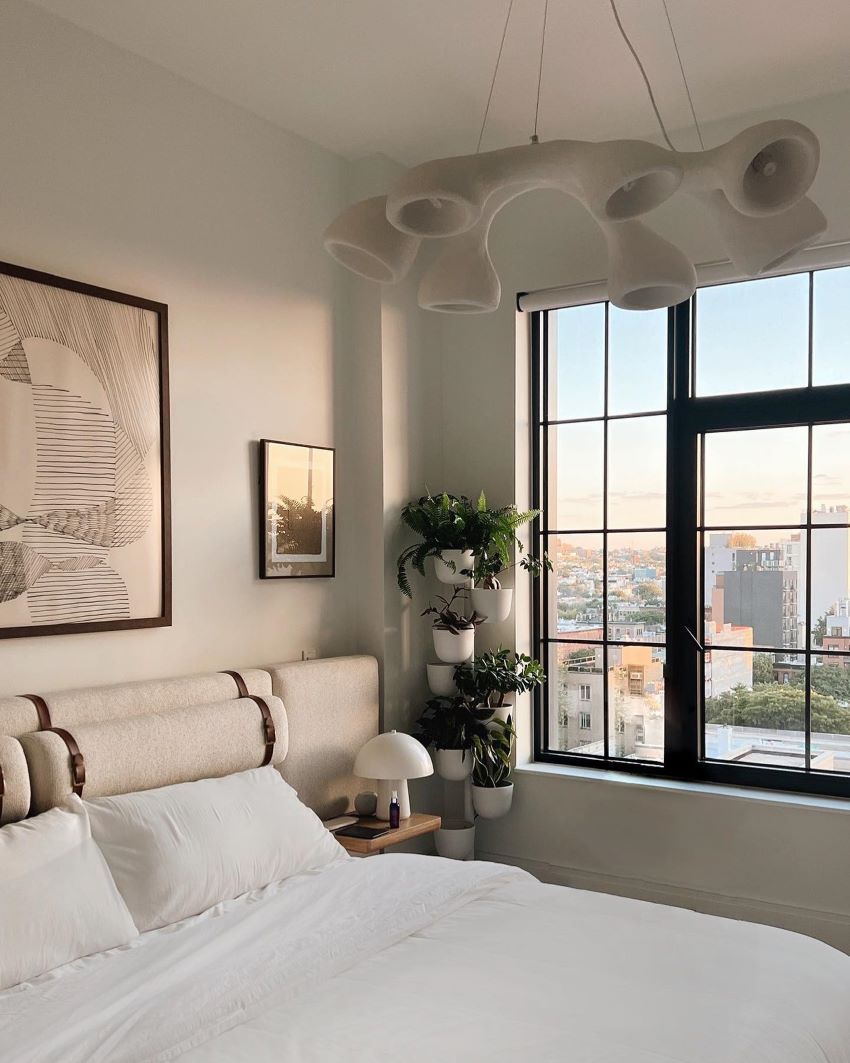
Photo by: Veyebs
Bedroom styling tips
A well-styled bedroom is more than aesthetics—it’s about creating a space that feels restful, functional, and inviting after a long day. Instead of overloading it with trends, focus on practical details that elevate comfort and style.
- Rethink your bed placement: While centering the bed against the main wall is common, it’s not always the best layout. Try positioning your bed against a window to create a soft, airy backdrop or floating it away from the wall in a large room for a more intentional design.
- Decorate your bed: The bed is naturally the room's focal point, so styling it is a no-brainer. While having a matching bed set is great, go the extra mile and use runners and decorative pillows to bring in a sense of luxury.
- Upgrade your nightstands: Think beyond basic bedside tables—a small desk, a vintage chest, or wall-mounted shelves can add function and character.
- Make use of the foot of the bed: Instead of leaving this space empty, add a bench, a pair of stools, or a low bookshelf to create a polished look.
- Create a dressing space: Even in small bedrooms, a designated area for getting ready adds a touch of luxury. A simple vanity with a stool, a floor mirror paired with a small side table, or a chic clothing rack can make your space feel intentional and functional.
The best bedrooms feel purposeful and personal—focus on a few thoughtful details that reflect your style while keeping the space functional and uncluttered.
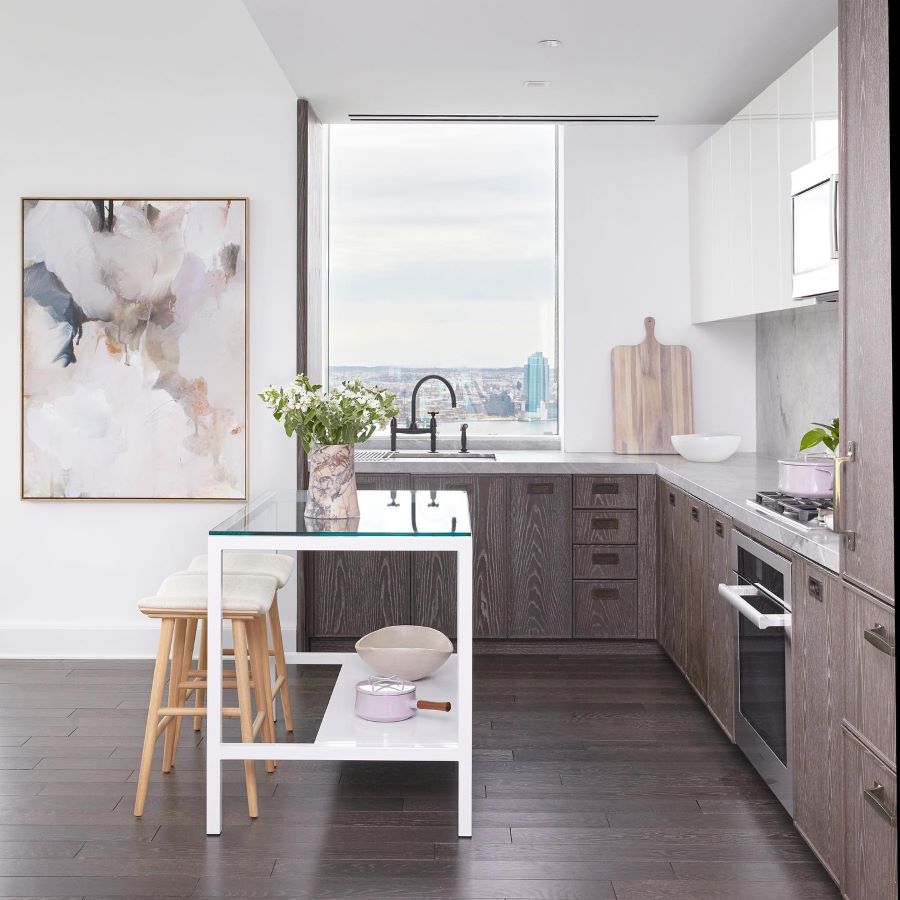
Photo by: Tara Benet
Kitchen and dining room decor
For most homeowners, the kitchen is a tricky place to style. But you don’t have to forego style for functionality! Some simple upgrades will take your kitchen from boring to beautiful in no time.
- Rethink countertop decor: Instead of cluttering your counters with purely decorative objects, choose beautiful and useful items. A sleek knife block, a well-designed coffee station, or an oversized bowl for fresh produce can add warmth while staying practical.
- Upgrade everyday essentials: Small swaps make a big impact—brass or matte black hardware or linen dish towels instantly elevate the space without major renovations. A stylish utensil holder or cutting board display can add texture while keeping essentials within reach.
- Create a coffee or beverage Nook: Dedicate a small kitchen section to coffee, tea, or cocktail-making essentials. A tray with mugs, a French press, and a glass canister of beans can make morning routines feel intentional, while a built-in bar area stocked with glassware and mixers sets the stage for entertaining.
- Mix open and closed storage: Open shelving or glass-front cabinets allow you to display your favorite dishes, cookbooks, or art, while closed storage keeps the less attractive necessities out of sight.
- Incorporate art into unexpected places: Kitchens often get overlooked when it comes to artwork, but a print propped on a shelf, a small gallery wall, or a framed recipe from a family member can make the space feel more personal.
7. Mix textures and materials
The best-designed spaces feel effortless because they blend different materials in a way that keeps things intriguing. Pairing polished surfaces like marble or glass with raw elements like weathered wood or woven rattan creates a contrast that makes each material stand out. Instead of sticking to just one type of finish, try combining matte ceramics with glossy metals or soft textiles with structured furniture to keep the room from looking too uniform.
Even small contrasting additions—like a metal-framed mirror against fabric-covered walls or a smooth leather ottoman near a textured wool rug—spark visual interest and invite touch, making your space feel more inviting and lived-in. Remember, balance is key—too much of one texture can overpower, while a thoughtful mix keeps things engaging!
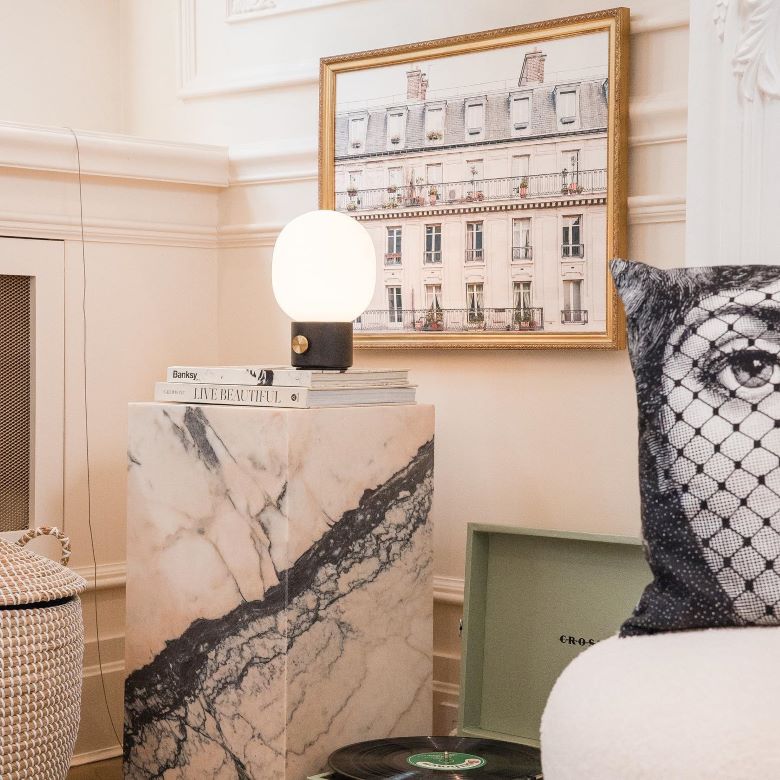
Photo by: Michelle Trinh
Mix different mediums
No dish is complete without mixing! Mixing photography, paintings, and prints allows each piece to bring something different to the table, whether it's color, texture, or mood. A sleek photograph next to a bold abstract painting or a hand-drawn sketch paired with a graphic print makes a space feel more collected and full of personality.
Instead of matching frames perfectly, try mixing matted prints with float-mounted canvases or even leaving some pieces unframed for a more relaxed look. The best spaces feel like a mix of different influences rather than a showroom, so go ahead and blend styles in a way that feels right to you.
Display ceramics and sculptures
There’s a reason kids are fascinated by shapes—there’s something instantly engaging about objects with curves, edges, and unexpected forms. That same intrigue applies to ceramics and sculptures in your home. Unlike flat artwork, these pieces add dimension and movement, pulling the eye in different directions and making a room feel more dynamic.
The trick is to mix heights and textures—a chunky stone sculpture next to a delicate bowl, or a sleek ceramic against a rougher material—to keep things visually interesting. And don’t just stick to shelves; place a bold vase as a dining table centerpiece, a sculptural piece on a stack of books. These pieces aren’t just accents; they make a space feel unexpected and full of character.
8. Define Your Space with the Right Flooring
Floors are the most overlooked design element in a home—until you get them wrong! The right flooring does more than just complement your decor, it influences the way a space feels, sounds, and functions.
Classic hardwood brings warmth and character, while tile offers endless design possibilities with patterns, colors, and textures. Vinyl and laminate have come a long way, now offering realistic finishes that mimic natural materials without extensive upkeep.
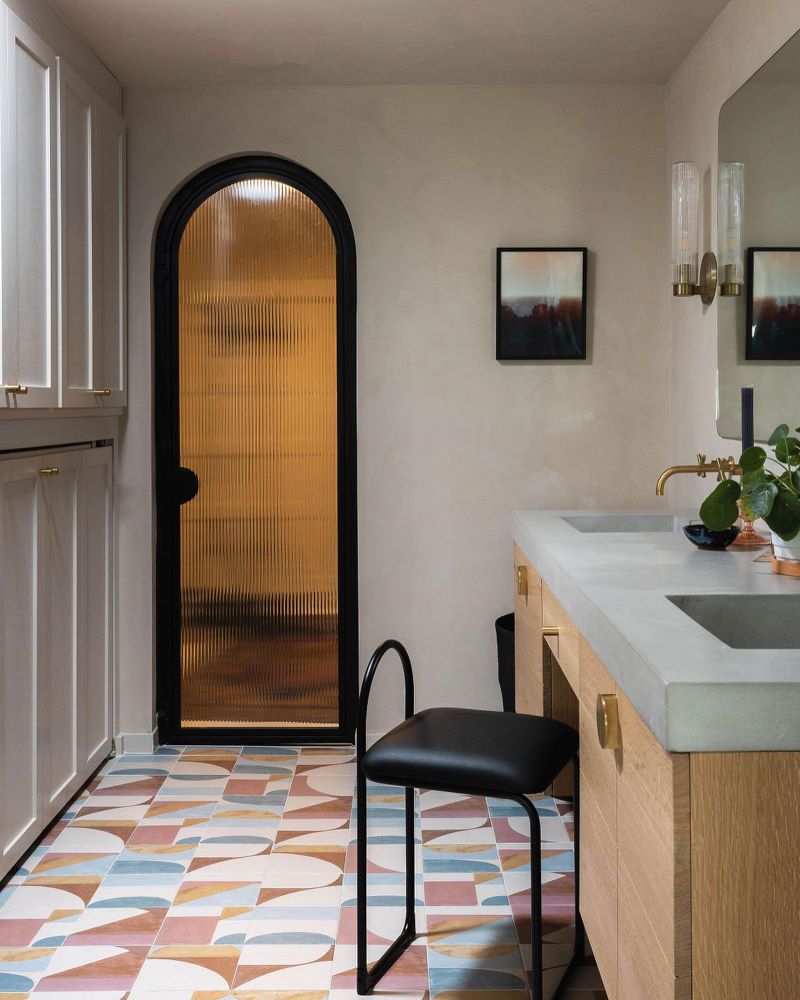
Photo by: Amanda Jacobs Design
Beyond aesthetics, flooring impacts how a home flows. Consistency in material across open spaces can make a home feel more expansive while mixing materials—like wood in living areas and tile in high-traffic zones—can add both style and practicality.
Even subtle choices, like plank width or tile layout, can affect the room’s proportions, making a space feel longer, wider, or more structured. Flooring isn’t just a backdrop—it’s a design decision that shapes how you experience your home.
Pro Tip: Consider adding a rug that complements your flooring to add a touch of warmth and elegance. Minted offers a variety of rug styles that could match your aesthetic brilliantly.
9. Incorporate seasonal decor
Your home changes with the seasons more than you realize—sunlight shifts, temperatures drop or rise, and even the way you use your space evolves. So why not let your decor follow suit? Refreshing your home with seasonal updates isn’t just about aesthetics—it’s about comfort, practicality, and making your space work better year-round.
In warmer months, swap out heavy textiles for breezier fabrics—linen curtains, lightweight throws, and cotton bedding help keep things cool and airy. When the chill sets in, bring in chunky knit blankets, velvet cushions, and richer, layered textures to make your space feel warm and cozy. Small adjustments, like switching darker-toned table linens for crisp whites in summer or swapping bright, citrus-scented candles for woodsy, spiced fragrances in fall, can subtly shift the mood of a room.
But don’t stop there! A simple shift in your art, like swapping bright summer pieces for earthy autumn tones, can make a space feel more in tune with the season. As winter arrives, artwork featuring soft, snowy scenes or festive details creates a sense of coziness, while spring welcomes lighter florals and fresh, vibrant hues that reflect the energy of the outdoors.
10. Utilize Smart Storage as Home Decor
Making a home look stylish with art and decor is the fun part—but what about all the everyday stuff that needs a place too? Instead of cramming things into drawers or closets, let storage work as part of your design. Optimize your shelving and storage in a way that is convenient to manage clutter as well as being decorative.
Optimize Small Spaces
Small spaces aren’t limiting—they just require you to get creative! When every inch matters, thinking vertically is key.
Floating shelves, wall-mounted desks, and tall bookcases help free up floor space while adding visual appeal. While it might seem counterintuitive, larger pieces—like a statement art print —can make a small room feel more open by drawing the eye upward and creating a sense of expansion.
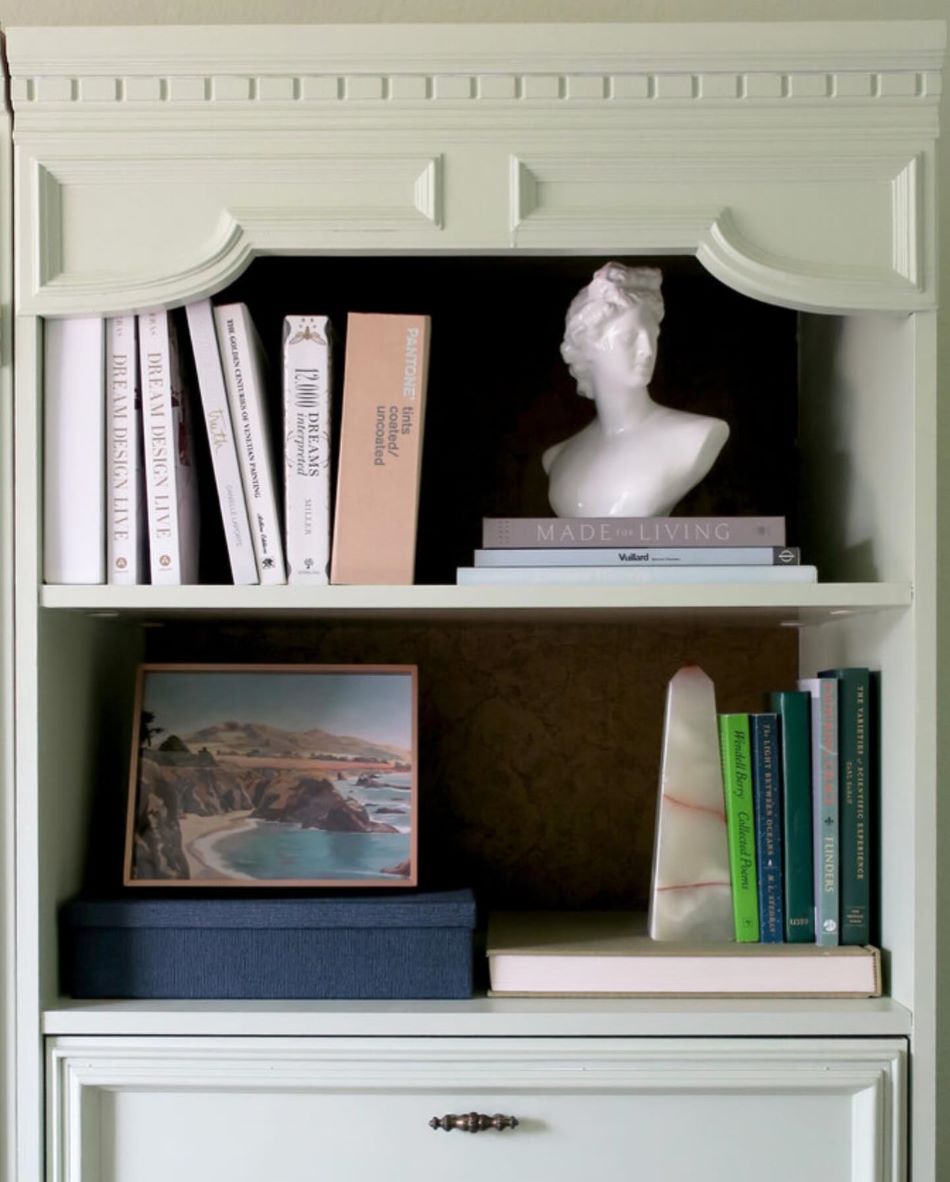
Photo by: Morrison Gates
Storage in compact areas can also be part of the decor itself. Woven baskets or decorative bins, help manage clutter while adding texture and warmth to a room. Stylishly displayed kitchenware, or even neatly arranged everyday essentials can add function without feeling out of place. Stacked cubbies with decorative boxes create extra space without making a room feel crowded.
For the little things that always seem to make a mess, like cords and chargers, sleek appliance cord boxes offer a simple way to keep them out of sight while keeping your space polished and put together.
The trick is to make sure everything serves a purpose—whether that’s to store, display, or enhance the space. With the right balance of practicality and personality, even the smallest rooms can feel well-designed and full of character.
Frequently asked questions about home decor
Decorating your home should be exciting, not overwhelming. If you’re feeling stuck, don’t worry—we’ve got answers to some of the most common home decor dilemmas.
How do I select the appropriate size art for my wall?
Think of art as a conversation with your space—it should feel proportionate, not like it’s getting lost or overpowering the room. For large walls, go bold with a statement piece or a balanced gallery wall. If you’re hanging art above furniture, keep it 5–7 inches above for a polished look. And here’s a quick trick: the center of your artwork should sit at about 57 inches from the floor for the best viewing experience.
I'm at the beginning of my decorating journey. Where can I find design inspiration?
Inspiration is everywhere! Start with Minted’s collection of art, where you can find fresh ideas for every style. Pinterest, design magazines, and even your favorite coffee shop can spark ideas, too. Save images that catch your eye and look for patterns—colors, textures, or moods you keep coming back to. That’s the foundation of your style.
Should my artwork perfectly complement my room's existing decor?
Not at all! A perfect match can sometimes feel too safe. Instead, choose art that speaks to you—something that makes you pause, smile, or feel something. Contrast can make a room more interesting, so if a piece feels right to you, chances are it will find its place in your space beautifully.
How can I tastefully decorate a compact living area?
Small spaces just require you to make creative and smart choices:
- Mirrors open up the room by bouncing light around.
- Multi-functional furniture (like a storage ottoman or wall-mounted desk) keeps things tidy.
- A few larger art pieces feel more intentional than lots of small ones.
- Vertical and elongated furniture like bookshelves or a decorative ladder draw the eyes up while making storage easy.
What's the best approach to creating a cohesive color palette in my room?
Let your artwork do the heavy lifting! Pull colors from your favorite piece and repeat them in throw pillows, rugs, or decorative accents. This simple trick ties everything together without feeling too matchy. It’s a foolproof way to make a space feel connected without overthinking it.
How do I maintain balance in home decor?
Think of your home like a great meal—it needs the right mix of flavors. If one element dominates, everything feels off. Balance comes from contrast and variety—pair sleek with textured, dark with light, and bold with neutral. Layer in warmth with rugs, art, or furniture with character. The key is mixing, not matching—when everything looks too coordinated, it can feel flat.
What are some affordable ways to decorate my house?
Style doesn’t have to come with a hefty price tag. Rearrange what you already have—sometimes, shifting furniture or swapping decor between rooms can make everything feel new. Thrift and DIY—secondhand finds, repurposed items, and a fresh coat of paint can work wonders. And never underestimate the power of art and textiles—affordable prints, stylish throw pillows, and layering rugs can instantly change a room’s vibe without draining your budget.
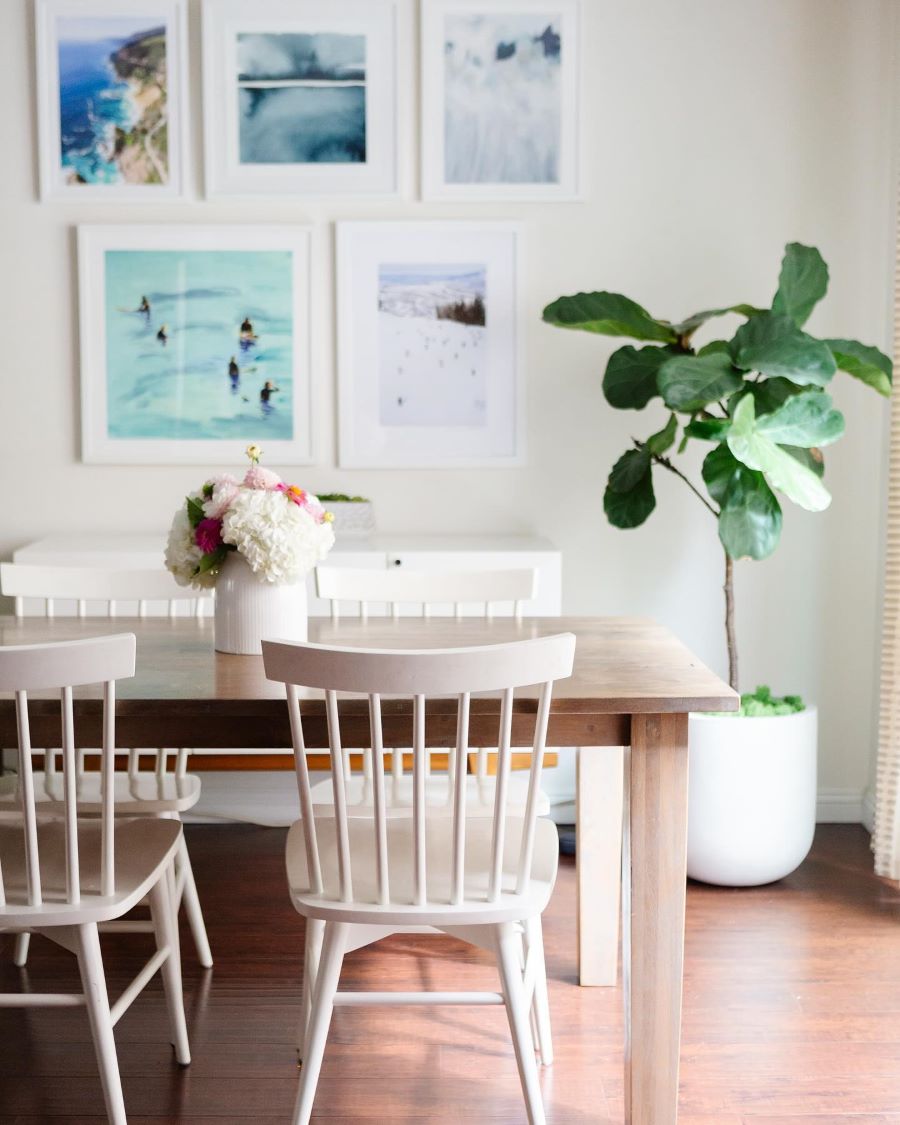
Photo by: Syd Freeman Interiors
What are the dos and don’ts of mixing decor styles?
Do: Find a common thread—whether it’s a color palette, material, or era—to tie everything together.
Don’t: Go overboard with statement pieces. A mix of styles should feel blended, not like a competition.
Do: Play with contrast—modern with vintage, industrial with organic—just keep it balanced.
Don’t: Force things to match perfectly. Mixing styles works best when it looks effortless.
How do I integrate art into an open floor plan?
Art helps define different areas in an open space. Use large statement pieces to anchor key zones—one over the sofa, another above the dining table—to give each area its own identity. A cohesive color scheme across different artworks keeps things connected without feeling repetitive.
What are the best types of frames for different art styles?
While there is no definite rule book for pairing frames with art, here are a few general ideas to guide you:
- Classic paintings & portraits: Ornate or vintage wood frames bring out their character.
- Minimalist prints & photography: Thin metal or simple black/white frames keep it sleek.
- Eclectic or mixed-media art: Float frames or natural wood let the artwork shine.
- Abstracts or bold modern pieces: Try a matless frame or a frameless canvas for a clean, contemporary look.
Bring your home to life
Decorating isn’t just about filling space—it’s about creating a home that feels like you. From mixing textures to playing with scale and layering in personal touches, every choice adds character and warmth. Your home should tell your story, reflecting what you love and how you live.
With Minted’s art collection, you have endless ways to bring personality into your space—whether it’s a statement piece that sparks conversation or a curated gallery wall that makes every room feel complete. So why settle for generic decor when you can surround yourself with pieces that inspire? Explore new styles, experiment with fresh ideas, and have fun with the process. Your home is your canvas—make it one you love coming back to.




